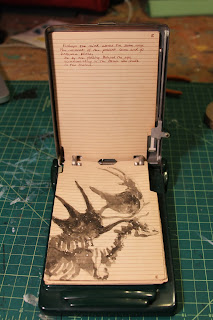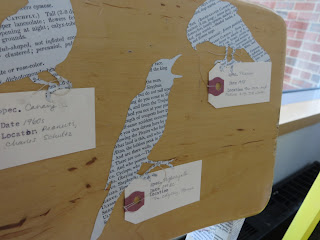This past weekend, myself and four artists plus a huge team of volunteers convened on Cheryl Capezzuti's studio to turn our cars into enormous works of art!
The theme for this year's Art Cars is "Special Delivery." I'm making a car covered in a flock of cranes, a bird that has long been associated with good luck and the New Year around the world, especially in Japan. Cranes worldwide continue to struggle against habitat destruction, and U.S. populations of rare Whooping Cranes have slowly increased, but they are still very endangered. The cranes on my car are bringing good luck, but also a reminder of the fragility of these wonderful birds' futures.
Read about the first step - making the canvas slipcover -
here in an earlier entry. This weekend, we began by wrapping my car in plastic to protect it from paint.
Once I got the slipcover back on, I sketched out the design - a siege of cranes (which is apparently the proper term for a flock of cranes) traveling through a night sky. I realize cranes don't fly at night, since they require a lot of thermal energy to soar while migrating - and they generally don't flap their wings much except for takeoff and landing - but I'm hoping my artistic license will be forgiven by parade attendees.
I had a squadron of individuals helping all weekend, doing everything from painting large blocks of color to refining detail work. One volunteer (whose name I unfortunately didn't learn) did all of the wonderful red crests on the crane heads.
Here's the slipcover in a near-complete state. I went back in a few times on Sunday and added some light definition to the cranes' bodies and wings. The bodies look a bit awkward since I drew them all higgeldy-piggeldy and freehanded (several kids said they liked my swans. Uh oh!). I've also got to paint more black on their faces, so they look a bit more like Whooping Cranes.
The back features an excerpt of a poem by Stephen Crane (author of "The Red Badge of Courage") entitled "I met a seer." I was thinking a lot about efforts in wildlife conservation and the challenges cranes still continue to face while googling "crane + poetry" and came across this poem. It seemed like an appropriate message to remind me of the pitfalls and imperfections in humanity's attempt to right its many ecological wrongs.
My friend Jenn valiantly spent an entire day cutting crane shapes out of coroplast (corrugated plastic) so we could assemble the 3-D components on Sunday:
Here are some complete and partially-assembled coroplast cranes by the car. I think I've got nine total. They're held together with a combination of white duct tape, zip ties, and snug part fitting.
The completed cranes will be mounted to the top of the car at varying heights. I've also set aside a few for the parade marchers who will be guiding my car to hold while they walk - there's me trying one out. A bamboo pole is enough to support the weight of the crane, and the bottoms of the wings are reinforced with sticks of willow that are just flexible enough to allow the wings some nice up-down movement.
Here are a few of the other artists' designs - a spacecraft that will feature waving aliens, and a toaster making some very special non-Jesus-face toast, with Hendrix and Elvis (flip side). There's also a giant blue mystic deer head car and a Dr. Who car featuring a TARDIS atop a time vortex.
I've still got to finish assembling and painting the faces on my coroplast cranes, but the majority of the work was finished in one very busy weekend! I'm eternally grateful for the many, many individuals who lent a hand, organized the weekend, and fed us. My thanks go out to Karen, Rose, Jenn, Barbara, Melinda and family, Tirzah, Sarah, Dave, Anna, Ryder, and Cheryl and everyone who helped out!














































